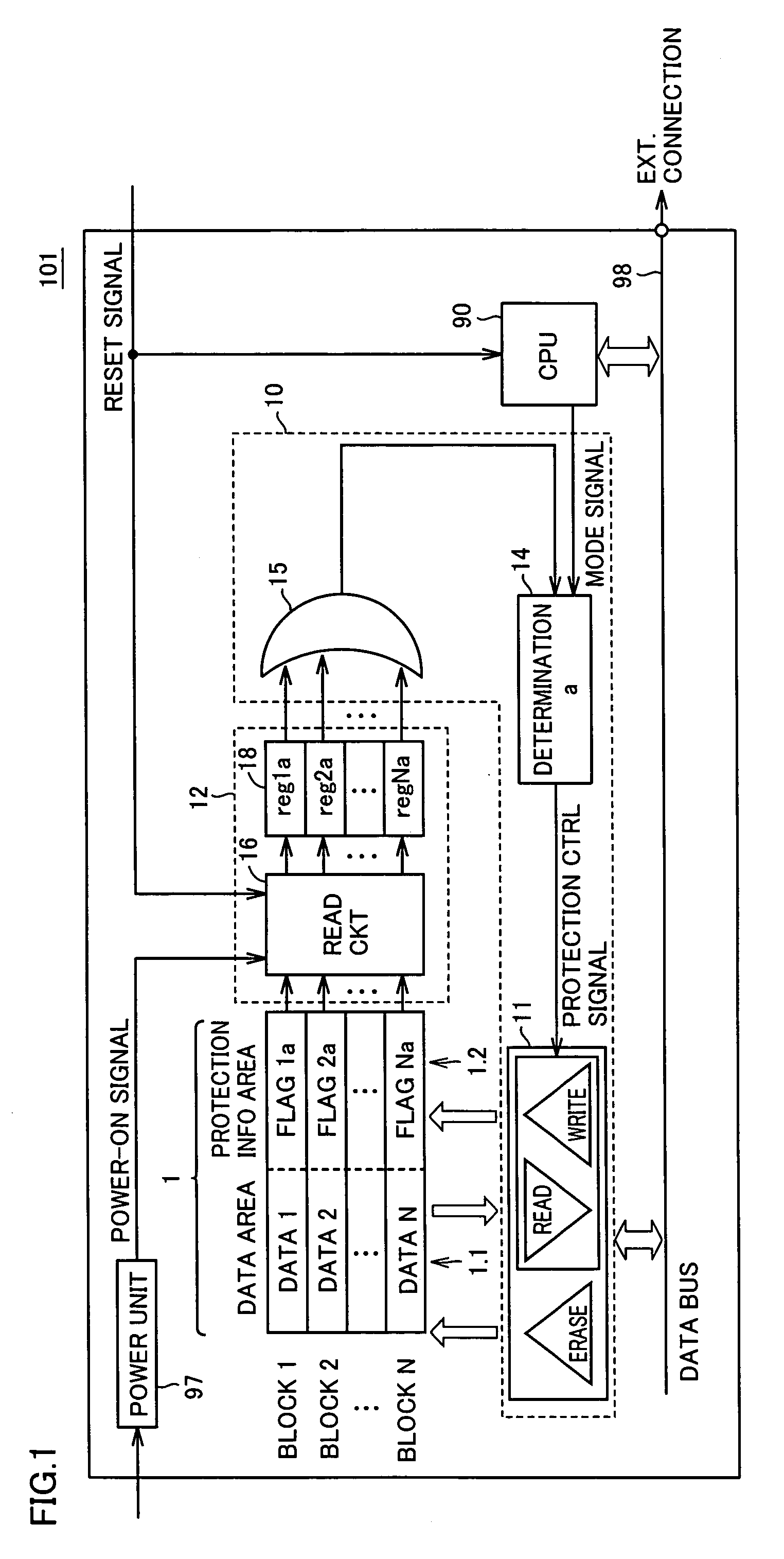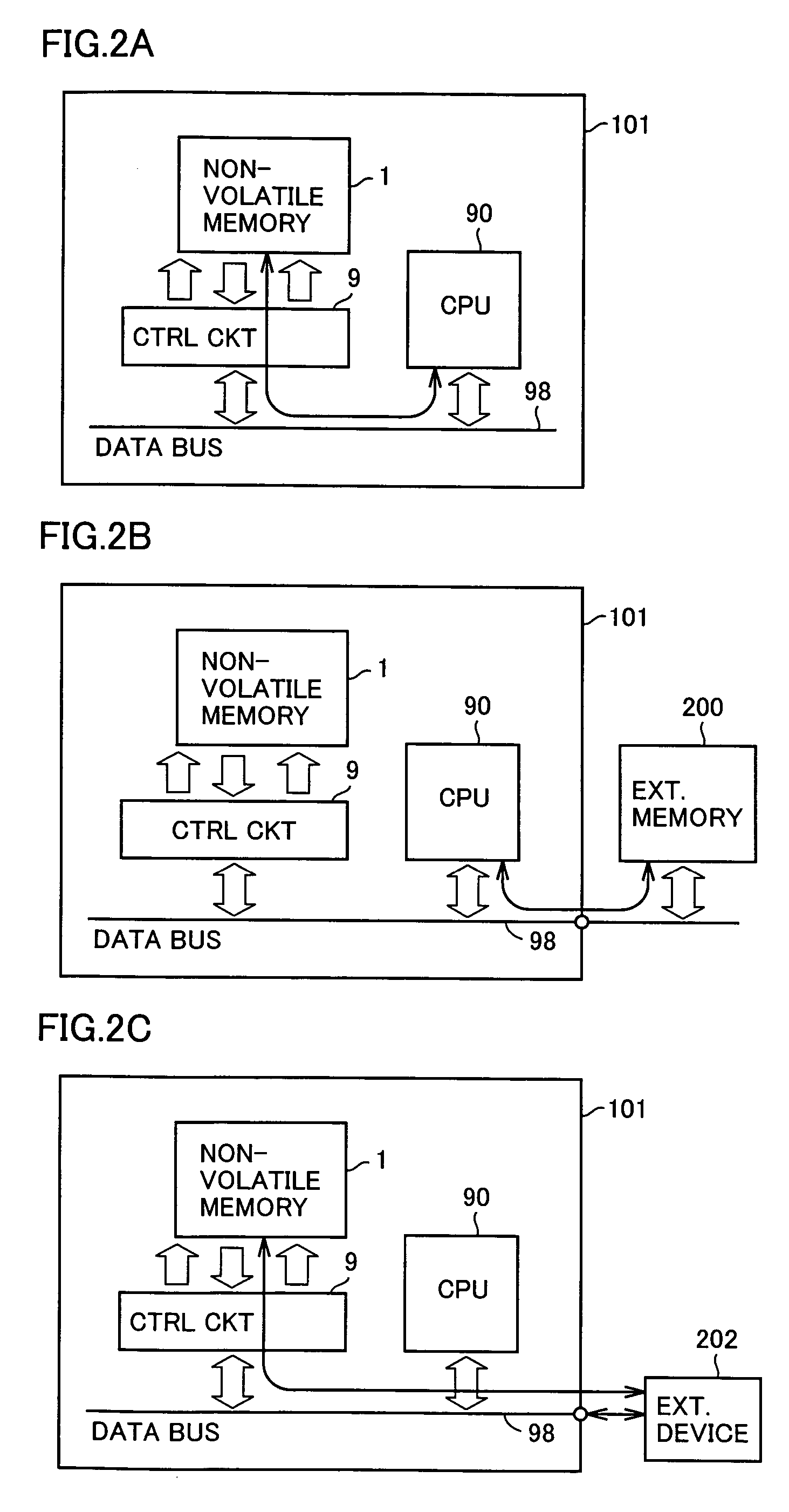Data protection for non-volatile semiconductor memory using block protection flags
a technology of block protection and semiconductor memory, applied in the field of semiconductor devices with can solve problems such as security holes, unrighteous reading of program contents by competitors, and possible failures of operations or human suffering, and achieve the effects of high data confidentiality protection functions, simple processing, and not lowering processing speed
- Summary
- Abstract
- Description
- Claims
- Application Information
AI Technical Summary
Benefits of technology
Problems solved by technology
Method used
Image
Examples
embodiment 1
[0037]Embodiment 1 is directed to a protection function proposed for an IP vendor or a programmer considering protection against an end user.
[0038]Referring to FIG. 1, a semiconductor device 101 in accordance with Embodiment 1 includes a data bus 98, an operating unit (CPU: Central Processing Unit; hereinafter also denoted by “CPU”) 90, a non-volatile memory 1, a reading unit 12, a control unit 10 and a power unit 97.
[0039]Data bus 98 connects CPU 90, control unit 10, an external memory (not shown) and an external device (not shown) to each other, mediating data exchange.
[0040]CPU 90 passes data to / from non-volatile memory 1 through data bus 98. Receiving a reset signal from the outside, CPU 90 reads a program stored in non-volatile memory 1 or an external memory (not shown) to be activated, in accordance with an operation mode, as will be described later. Further, when CPU 90 reads a program from non-volatile memory 1 to be activated, it outputs a mode signal thereof to control uni...
embodiment 2
[0070]In Embodiment 1, a semiconductor device having a protection function proposed for an IP vendor or a programmer considering protection against an end user has been described.
[0071]In Embodiment 2, a semiconductor device having a protection function proposed for an IP vendor considering protection against a programmer or an end user will be described.
[0072]Referring to FIG. 3, a semiconductor device 102 in accordance with Embodiment 2 includes a data bus 98, a CPU 92, a non-volatile memory 2, a reading unit 22, a control unit 20 and a power unit 97.
[0073]Data bus 98 connects CPU 92, control unit 20, an external memory (not shown) and an external device (not shown) to each other, mediating data exchange.
[0074]CPU 92 passes data to / from non-volatile memory 2 through data bus 98. Similar to CPU 90 in accordance with Embodiment 1, when CPU 92 reads a program from non-volatile memory 2 to be activated (in the “activation mode on a program in a memory of the microcomputer”), it output...
embodiment 3
[0095]In Embodiments 1 and 2, protection functions directed to different objects have been described.
[0096]In Embodiment 3, a semiconductor device that can simultaneously realize functions of Embodiments 1 and 2 will be described. In the following description, for clarification, the protection in accordance with Embodiment 1 is also referred to as “overall protection,” and protection in accordance with Embodiment 2 is also referred to as “partial protection.”Referring to FIG. 4, a semiconductor device 103 in accordance with Embodiment 3 includes a data bus 98, a CPU 92, a non-volatile memory 3, a reading unit 32, a control unit 30 and a power unit 97.
[0097]Data bus 98 connects CPU 92, control unit 30, an external memory (not shown) and an external device (not shown) to each other, mediating data exchange.
[0098]CPU 92 passes data to / from non-volatile memory 3 through data bus 98. Similar to CPU 90 in accordance with Embodiment 1, when CPU 92 reads a program from non-volatile memory 3...
PUM
 Login to View More
Login to View More Abstract
Description
Claims
Application Information
 Login to View More
Login to View More - R&D
- Intellectual Property
- Life Sciences
- Materials
- Tech Scout
- Unparalleled Data Quality
- Higher Quality Content
- 60% Fewer Hallucinations
Browse by: Latest US Patents, China's latest patents, Technical Efficacy Thesaurus, Application Domain, Technology Topic, Popular Technical Reports.
© 2025 PatSnap. All rights reserved.Legal|Privacy policy|Modern Slavery Act Transparency Statement|Sitemap|About US| Contact US: help@patsnap.com



